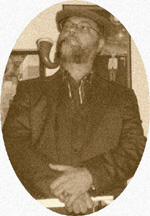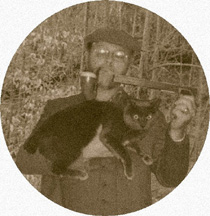|
Home
|
Sanford Thornwhistle Dunbar II A short monograph Sanford Thornwhistle Dunbar II A Short Monograph On The Life Of Sanford Thornwhistle Dunbar II Several readers have written asking whence came my interest in felines. My interest in cats, and their place in natural science, possibly stems from an ancestor, my great great uncle, Sanford Thornwhistle Dunbar II., (second cousin of Lord Channing Bentthistle Dunbar, magistrate of the village of Lower Cowwallis, in rural Bedfordshire county), a natural philosopher and a contemporary of both Sir Arthur Conan Doyle and Winston Churchill, though he was not acquainted with either. Thornwhistle's mother was a lachrymose woman who exited life early, after choking to death on a peach pit. Left to raise his son alone, the elder Thornwhistle became reclusive, developed an antipathy for his namesake, and much preferred devoting his time to maintaining his extensive collection of stuffed owls. In 1894, when Thornwhistle was twenty-two, and somewhat at odds about his future ambitions, his father informed him he had secured him an officer's commission in Her Majesty's Army, and a posting, and that he was to leave for duty in India within a fortnight. Greatly excited at this change in his fortunes, Thornwhistle promptly purchased the requisite gear and left for his tour of duty at the military garrison at Port Cornwallis in the Andaman Islands of India. Unfortunately, after Thornwhistle had been on the sub-continent of India only a few weeks, he suffered something of a nervous breakdown due to a severe shock to his senses when he learned that Britain had withdrawn its military presence from the Andaman Islands shortly after the Indian Mutiny of 1857, which was several decades before his arrival. This of course led to an abrupt end to his military career and also became a setback to his worldly ambitions. It did not help his relationship with his father, either. Thornwhistle returned to Britain and went into an early retirement. However, it was while Thornwhistle was in traveling in India that he first developed the interest in the natural sciences, and felines in particular, which was to stay with him throughout his life. While walking through a peasant village one morning, he came across a Hindu holy man who was exhibiting a talking cat which, for a small donation, answered questions posed by the villagers. Though the miracle of the talking cat seemed impressive on first glance, Thornwhistle used his keen analytical skills and quickly ascertained that common fakery was involved. The holy man who was displaying the voluble feline was a fakir who was employing common ventriloquist skills. As he sat the cat in his lap, the fakir held it by the back of its neck with his right hand and manipulated its bottom jaw up and down by grasping the fur under its chin with the thumb and first finger of his left hand, making the mouth appear to move in sync with his voice. Thornwhistle amazed the local villagers when he snatched the hapless and much puzzled feline from the fakir and repeated the phenomena, only making the cat speak in English. The assemblage was truly astounded, and the feline got halfway through a rendition of a chorus of Hail Britannia before scratching Thornwhistle severely and running off, closely pursued by dozens of gullible peons who (not quite having gotten the point of Thornwhistle's display), now wanted to worship the cat and seek its divine guidance more than ever since it had proven itself a polyglot. Thornwhistle had not long returned from his sojourn to the East when his father died unexpectedly, leaving him heir to Thornwhistle Estates. Having a small annuity to live on, Thornwhistle decided to devote his life to the study of natural philosophy and cats. For well on fifty years Sanford Thornwhistle Dunbar, II could be seen every day walking about the rural countryside of Bedfordshire county. Thornwhistle took his morning peregrinations seriously and never missed a day. As well as being intimately familiar with every type of flora and fauna about the countryside, it was said that he could identify each and every one of the cats he came upon by name. In fact, Thornwhistle was among the first on the British Isles to be diagnosed with Feline-pseudonymia, which is the uncontrollable impulse to bestow a name on each stray cat one passes. Thornwhistle was an incessant writer of monographs and tackled a variety of subjects related to nature; in fact, two of Thornwhistle's monographs - "The Effect Of Starlight On The Hydration Of Tomato Plants," and "Certain Observations Regarding The Mating Habits Of The Crested Loon" - were actually considered for publication briefly. Like his father an impulsive collector, Thornwhistle at one time possessed one the most extensive collections of twigs in Bedfordshire county. A rare photograph of Thornwhistle scientifically examining one of the many unfortunate tail-less gray cats of Devonshire county Thornwhistle frequently explored truisms espoused by the quaint local villagers. One such truism he determined to investigate was the popular folk maxim that gray cats possessed a magical property, so that if one pulled the tail of a gray cat one thousand times, it would rid one of warts. Unfortunately, due to the prevalence of this belief about the countryside, and the enormous number of villagers in Bedfordshire who were heredity wart-bearers, there were few gray cats with tails to be found in the area; hence the truth of the maxim remained untested.* *The sad tail-less gray cats of Bedfordshire faired luckier than the white-coated cats that formerly inhabited Devonshire county, whose residents believed that due to their color they were properly classified as rabbits, or hares, and thus edible fare. Previously consigned to the barns of the lower classes as mouse catchers, cats were not used as house pets among the upper classes until people like Thornwhistle developed methods of making them more amenable to indoor living. To that end, Thornwhistle came up with several innovations designed at popularizing cat-keeping, or cat-hobbying, as it was then called, among the gentry. This was primarily in the form of corrective behaviors, or behaviorism, as Thornwhistle termed it, which he employed on his own brood of indoor felines. For example, it was Thornwhistle's suggestion that if an indoor cat made an inappropriate toilet in the house, that the butler gather the offending lumps of excrement and bind them to the cat's body by mean's of cloth bandages for the duration of a week. The primary result of this was that humans, other cats, and most animals with sensitive noses, gave wide berth to any feline in the vicinity wearing bandages about its torso. However, since cats are by nature solitary creatures anyway, this corrective behaviorism seemed to be of little effect. Another behavioral treatment, a later modification on the bandages, was that a cat who persisted in non - toilet deposits be put on a regular schedule of enemas, provided by the butler. This worked better than the bandage method, Thornwhistle admitted grudgingly, though there were some peculiar felines who developed an unnatural fondness for the procedure. For cats who exhibited occasional overt feral tenancies, such as hissing, spitting, scratching, or purring incessantly, Thornwhistle recommended having the offending beast tied to a chair for six hours while the butler read Shakespeare's King Lear to it. Though the method was never known to produce either a literate or a well - behaved cat, Thornwhistle continued to champion it as long as he lived. On August 14, 1927, Thornwhistle's smoldering remains were found by a chimneysweep who had come to service the chimneys at Thornwhistle Estates. The local populace was at first greatly excited since this seemed to be the first case of SHC (Spontaneous Human Combustion) that Bedfordshire County had experienced; however, after a brief inquiry, the county coroner deduced the cause of the conflagration to be the large calabash pipe that was Thornwhistle's constant companion, which set off the contents of a decanter of brandy that had spilled into the unfortunate man's lap. His death was not without controversy, however. There were some locals who maintained that Thornwhistle's butler - who had developed a pronounced antipathy towards both cats and Thornwhistle during his employment at Thornwhistle Estates - set him on fire while he was asleep in his chair. The allegation was never proven and the coroner's original report stood. Thus ended the life of a remarkable pioneer in the natural sciences and a great benefactor of pussycats. |

